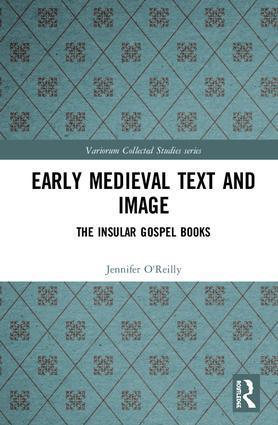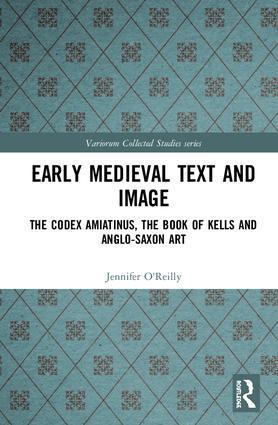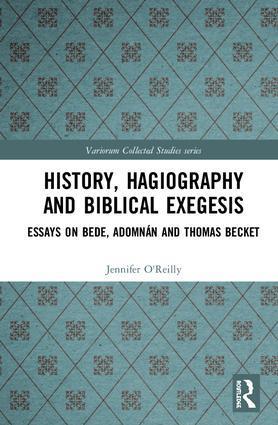Publications
During her lifetime Jennifer O’Reilly was urged by her students and fellow scholars to collect her scattered essays for interested readers, but she did not live to do so.
When she died in 2016, Dr O’Reilly left behind a body of published work in three areas of medieval studies: the writings of Bede and his older Irish contemporary, Adomnán of Iona; the early lives of Thomas Becket; and the iconography of the Gospel Books produced in early medieval Ireland and Anglo-Saxon England. In these three areas she explored the connections between historical texts, artistic images and biblical exegesis. The aim of the three volumes, published simultaneously by Routledge in 2019, is to realise that ambition. Seen together, the essays gathered in these books highlight her distinctive approach to historical sources, and her substantial contribution to our understanding of England and Ireland in the Middle Ages.

‘Most users of these books will have read several of these essays before, but having them in one place is more than a convenience: it allows us to note continuities both within Jennifer O’Reilly’s work (thus making for a more fruitful engagement with her researches) and also to recognize continuities in the artefacts themselves. Moreover, we have not simply been given reproductions of the earlier papers ... but the works have been reset and all the appropriate illustrations have been reproduced in colour — more than 150 in total — close to where they are discussed allowing us to see exactly what is meant in the various iconographical analyses. These sharp, clear colour images, along with two indices, make these books works of scholarship in their own right. We are indebted to the editors for their work for us, as well as for having given us such an appropriate monument to a great scholar’ – Thomas O’Loughlin, Irish Theological Quarterly 2020, Vol 85 (3).
Review: Tom O’Loughlin, Irish Theological Quarterly. 85 (3): 307–309 http://journals.sagepub.com/doi/10.1177/0021140020929902
History, Hagiography and Biblical Exegesis
“This collection brings into sharp focus O’Reilly’s contributions to medieval studies, especially her profound expertise in Scripture and her sensitivity to the spiritual and theological motivations of Bede and Adomnán” – Sharon M. Rowley, Peritia, Journal of the Medieval Academy of Ireland. 31 (2022): 317–321
Early Medieval Text and Image, Volumes 1 and 2
‘Everyone looked at the Book of Kells differently when they heard Jennifer O’Reilly talk about it. Her scholarship changed the landscape of the subject.’ – Bernard Meehan, Peritia, Journal of the Medieval Academy of Ireland. 31 (2022): 299–300
- History, Hagiography and Biblical Exegesis: Essays on Bede, Adomnán and Thomas Becket, eds. Diarmuid Scully, Tom O’Reilly and Máirín MacCarron (Routledge: Variorum, 2019)
Table of contents
Bede
- Introduction to On the Temple
- Islands and idols at the ends of the earth: exegesis and conversion in Bede’s Historia ecclesiastica
- Bede on seeing the God of gods in Zion
- The multitude of isles and the corner-stone: topography, exegesis and the identity of the Angli in Bede’s Historia ecclesiastica
- St Paul and the sign of Jonah. Theology and Scripture in Bede’s Historia Ecclesiastica
- Bede and Monothelitism
- The image of the Mediator in the work of Bede
Adomnán
- Reading the scriptures in the life of Columba
- The wisdom of the scribe and the fear of the Lord in the Life of St Columba
- Adomnán and the art of teaching spiritual sons
- Columba at Clonmacnoise
- The Bible as map, on seeing God and finding the way: pilgrimage and exegesis in Adomnán and Bede
Thomas Becket
- Candidus et rubicundus: an image of martyrdom in the lives of Thomas Becket
- The double martyrdom of Thomas Becket: hagiography or history?

- Early Medieval Text and Image: The Insular Gospel Books, eds. Carol Farr and Elizabeth Mullins (Routledge: Variorum, 2019)
Table of contents
Insular Gospel Books
- Early medieval text and image: the wounded and exalted Christ
- The Hiberno-Latin tradition of the Evangelists and the gospels of Máel Brigte
- Gospel harmony and the names of Christ in Insular gospel books
- Patristic and Insular traditions of the Evangelists: exegesis and iconography
- “Know who and what he is”: the context and inscriptions of the Durham Gospels Crucifixion image
- The image of orthodoxy, the mysterium Christi and Insular Gospel books
- St John the Evangelist: between two worlds
- Seeing the crucified Christ: image and meaning in early Irish manuscript art
- The St Gall Gospels: art and iconography

- Early Medieval Text and Image: The Codex Amiatinus, the Book of Kells and Anglo-Saxon Art, eds. Carol Farr and Elizabeth Mullins (Routledge: Variorum, 2019)
Table of contents
The Book of Kells
- The Book of Kells, folio 114: a mystery revealed yet concealed
- The Book of Kells and two Breton gospel books
- Exegesis and the Book of Kells: the Lucan genealogy
- Entry on the Book of Kells, folios 29 and 34
- Two pages from the Book of Kells
- The Book of Kells, folio 114
- The body of Christ in the Book of Kells
The Codex Amiatinus
- The library of Scripture: views from Vivarium and Wearmouth-Jarrow
- Celtic art and the Gospel
- The art of authority
- “All that Peter stands for”: the romanitas of the Codex Amiatinus reconsidered
The Anglo-Saxon and Later English Traditions
- An Anglo-Saxon portable altar: inscription and iconography
- St John as a figure of the contemplative life
- The rough-hewn cross in Anglo-Saxon art
- Text and image in Anglo-Saxon Benedictine reform
- Signs of the Cross
- The medieval iconography of the two trees in Eden
All publications
Bede
- Introduction to On the Temple, tr. Seán Connolly, Translated Texts for Historians, vol. 21 (Liverpool University Press, 1995) xvii–lv.
- ‘Islands and idols at the ends of the earth: exegesis and conversion in Bede’s Historia ecclesiastica’, in Bède le vénérable. Entre tradition et posterité, ed. Stephane Lebecq, Michel Perrin and Olivier Szerwiniack, (Lille, 2005) 119–145.
- ‘Bede on seeing the God of gods in Zion’, in Text, image and interpretation. Studies in Anglo-Saxon literature and its Insular context in honour of Éamonn Ó Carragáin, ed. Alastair Minnis and Jane Roberts, (Brepols, Turnhout, 2007) 3–29.
- ‘The multitude of isles and the corner-stone: topography, exegesis and the identity of the Angli, in Bede’s Historia ecclesiastica’, in Anglo-Saxon Traces, ed. Jane Roberts and Leslie Webster (Arizona Center for Medieval and Renaissance Studies, Tempe, 2011) 201–27.
- ‘St Paul and the sign of Jonah. Theology and Scripture in Bede’s Historia Ecclesiastica’, (Jarrow Lecture, 2014.).
- ‘Bede and Monothelitism’ (In press and forthcoming).
- ‘Bede and the Mediator’ (Forthcoming).
Adomnán
- ‘Reading the Scriptures in the Life of Columba’, in Studies in the cult of St Columba, ed. Cormac Bourke (Dublin, 1997) 80–106.
- ‘The wisdom of the scribe and the fear of the Lord in the Life of St Columba’, in Spes Scotorum. Hope of Scots, ed. Dauvit Broun and Thomas Owen Clancy(Edinburgh, 1999) 159–211.
- ‘Adomnán and the art of teaching spiritual sons’, in Adomnán of Iona: theologian, lawmaker and peacemaker, ed. Jonathan Wooding, Thomas O’Loughlin et al. (Dublin, 2010) 69–94.
- ‘Columba at Clonmacnoise’, in Sacred Histories. A Festschrift for Máire Herbert, John Carey, Kevin Murray and Caitríona Ó Dochartaigh (Dublin, 2015) 380–390.
- ‘The Bible as Map, On Seeing God and Finding the Way: Pilgrimage and Exegesis in Adomnán and Bede’, in Place and Space in the Medieval World, ed. Meg Boulton, Jane Hawkes and Heidi Stoner (Routledge, New York and London, 2018) 210–226.
Thomas Becket
- ‘Candidus et rubicundus: an image of martyrdom in the Livesof Thomas Becket’, Analecta Bollandiana 99 (1981) 303–14.
- ‘The double martyrdom of Thomas Becket: hagiography or history?’, Studies in Medieval and Renaissance History7 (1985) 185–247.
Medieval Art
- ‘Iconoclasm’, review article, Eastern Churches Review 10 (1978) 165–9.
- Studies in the iconography of the Virtues and Vices in the Middle Ages (New York and London, 1988).
- ‘Early medieval text and image: the wounded and exalted Christ’, Peritia 6–7 (1987–88) 72–118.
- ‘The medieval iconography of the two trees in Eden’, in A walk in the garden: biblical, iconographical and literary images of Eden, ed. P. Morris and D. Sawyer, Journal for the Study of the Old Testament, supplement series 136, (Sheffield, 1992) 167–204.
- ‘Patristic and Insular traditions of the Evangelists: exegesis and iconography’, in Le isole Britanniche e Roma in eta romanobarbarica, ed. A. M. Luiselli and Eamónn Ó Carragáin (Rome, 1998) 49–94.
- ‘Celtic art and the Gospel’, Search 24 (2001) 34–42.
- ‘The art of authority’, in After Rome, ed. Thomas Charles-Edwards (Oxford, 2003) 141–189.
- ‘St John the Evangelist: between two worlds’, in Insular and Anglo-Saxon Art and Thought in the Early Medieval Period, ed. Colum Hourihane (Penn State University Press, 2011) 189–218.
- ‘Seeing the crucified Christ: image and meaning in early Irish manuscript art’, in Envisioning Christ on the Cross in the early medieval West, c.500–1200, ed. Juliet Mullins and Jenifer Ní Gradaigh (Dublin, 2013) 52–82.
The Anglo-Saxon Tradition
- ‘An Anglo-Saxon portable altar: inscription and iconography’ (with Elisabeth Okasha), Journal of the Warburg and Courtauld Institutes 47 (1984) 32–51.
- ‘The rough-hewn cross in Anglo-Saxon art’, in Ireland and insular art A.D. 500-1200, ed. Michael Ryan (Royal Irish Academy, Dublin, 1987; reprinted 2002) 153–58.
- ‘St John as a figure of the contemplative life: text and image in the art of the Anglo-Saxon Benedictine reform’, in St Dunstan: his life, times and cult, ed. N. L. Ramsay, M. J. Sparks and T. Tatton-Brown (Woodbridge, 1992) 165–85.
- ‘Testo e immagine nella riforma benedettina anglosassone’, in Benedetto l’Eredità Artistica, ed. Roberto Casanelli and E. López-Tello García, (Milan 2007) 95–110. Simultaneous publication in German (Benediktinische Kunst).
- ‘Signs of the Cross’, in The History of British Art 600-1600, ed. Tim Ayers (Tate Britain and the Yale Center for British Art, 2008) 176–99.
Insular Gospel Books
- ‘The Hiberno-Latin tradition of the Evangelists and the Gospels of Mael Brigte’, Peritia 9 (1995) 290–309.
- ‘Gospel harmony and the names of Christ in Insular gospel books’, in The Bible as book: the manuscript tradition, ed. J. Sharpe and K. Van Kampen (London, 1998) 73–88.
- ‘“Know who and what he is”: the context and inscriptions of the Durham Gospels Crucifixion image’, in Making and meaning in Insular Art, ed. Rachel Moss, (Dublin, 2007) 301–16.
- ‘The image of orthodoxy, the mysterium Christi and Insular Gospel books’, in L’Irlanda e gli irlandesi nell’alto medioevo, Settimane di studio della fondazione centro italiano di studi sull’alto medioevo, LVII (2010) 651–705.
- ‘The iconography of the St Gall Gospels’, forthcoming in the commentary volume accompanying the facsimile, ed. Damian Bracken.
The Codex Amiatinus
- ‘“All that Peter stands for”: the romanitas of the Codex Amiatinus reconsidered’, in Anglo-Saxon/Irish relations before the Vikings, ed. James Graham-Campbell and Michael Ryan, Proceedings of the British Academy 157 (Oxford, 2009) 367–95.
- ‘The library of Scripture: views from Vivarium and Wearmouth-Jarrow’, in New offerings, ancient treasures. Studies in medieval art for George Henderson, ed. Paul Binski and Will Noel (Stroud, 2001) 3–39.
The Book of Kells
- ‘The Book of Kells, folio 114: a mystery revealed yet concealed’, in The age of migrating ideas: early medieval art in Britain and Ireland, ed. J. Higgitt and R. M. Spearman (Stroud, 1993) 106–114.
- ‘Exegesis and the Book of Kells: the Lucan genealogy’, in The Book of Kells, ed. Felicity O’Mahony (Aldershot, 1994) 344–97. Reprinted in Scriptural interpretation in the Fathers, ed. Thomas Finn and Vincent Twomey (Dublin, 1995) 315–55.
- ‘The Book of Kells and two Breton gospel books’, in Irlande et Bretagne. Actes du colloque de Rennes 1993, ed. C. Laurent and H. Davis (Rennes, 1994).
- Entry on the Book of Kells, folios 29 and 34, in Histoire de l’écriture, ed. A. M. Christin (Paris, 1997; English version 2002).
- ‘Two pages from the Book of Kells’, in Visual practices across the University, ed. James Elkins, (Munich, 2007) 164–69.
- ‘The Book of Kells, folio 114’, in Treasures of Irish Christianity: people and places, images and texts, ed. Salvador Ryan and Brendan Leahy (Dublin, 2012) 49–52.
- 'The body of Christ in the Book of Kells', in Proceedings of the International Symposium of Theology: The Ecclesiology of Communion (Dublin: Veritas, 2013), 52-62.

